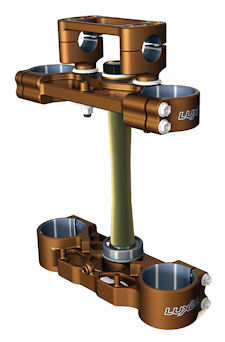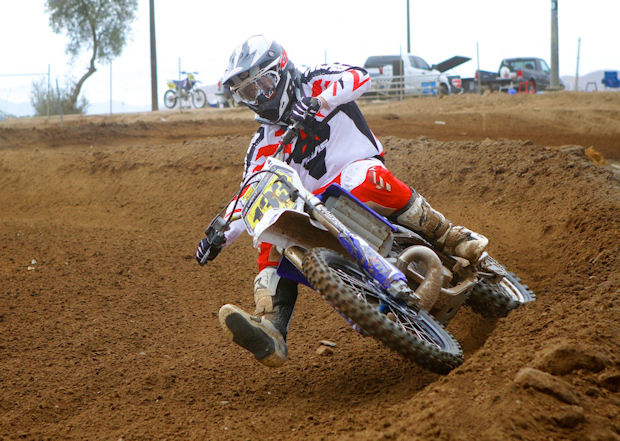
Fig.1. Billy Wight personally tests all of Luxon’s products. Image courtesy of Luxon MX.
Latest News
July 8, 2014
In the motocross industry, advanced product design and performance are crucial. Motocross bikes are built to withstand tremendous stress in demanding conditions. Riders and teams are always seeking better parts to give them the competitive edge. Well engineered parts offer advantages such as reduced weight, increased toughness to handle the rough-and-tumble environment in which they operate, and afford additional rider safety in an already dangerous sport.
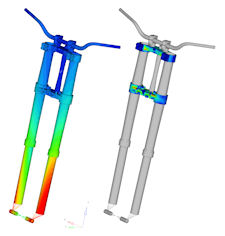 Fig. 2. FE models are used to evaluate OEM components and competing products. Image courtesy of Luxon MX.
Fig. 2. FE models are used to evaluate OEM components and competing products. Image courtesy of Luxon MX.“The market is saturated with products; however, few are designed using advanced tools and practices,” explains Billy Wight of Luxon MX. Luxon MX is an offshoot of Luxon Engineering, a San Diego-based product development and mechanical engineering firm. Luxon MX offers aftermarket parts for the motocross industry.
“The original equipment manufacturer (OEM) components are designed to get the job done with minimal cost,” Wight continues. “This opens the door for aftermarket companies designing parts for maximum performance. There are a lot of aftermarket companies making these parts, but none that use the optimization technology we do.”
Luxon’s first product began with the design of a triple clamp assembly, a bracket that holds the front suspension, steering and handlebars all in place.
“It’s a frequently updated component,” explains Wight. “It’s one of the most notable structural components on the bike, and one of the most highly stressed parts on the bike. In addition to the required strength and stiffness, this part is very important to the handling of the bike.”
Luxon MX sought a more performance-oriented design than what was currently available. Bound by strength requirements, the company sought to reduce weight, maintain stiffness and strength, and ensure an aesthetically pleasing design.
In its design process, the company used HyperWorks, Altair’s CAE simulation software platform, to setup and run analysis. It also employed Altair OptiStruct, Altair’s tool for optimization-driven structural analysis.
Design optimization applies various algorithms to optimize variables that are subject to constraints. Optimization applications are commonly employed by Luxon MX during the product development stage to efficiently drive the design forward.
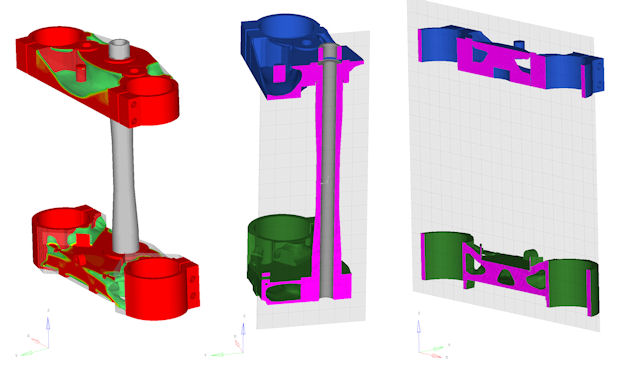 Fig. 3. Topology optimization results without manufacturing constraints applied. Note the undercuts and hollow sections. Image courtesy of Luxon MX.
Fig. 3. Topology optimization results without manufacturing constraints applied. Note the undercuts and hollow sections. Image courtesy of Luxon MX.“The term ‘optimization’ is often used in engineering as a buzzword, but true optimization involves computerized routines that remove the engineer from the process,” says Wight. “Computer routines avoid the designer’s intuition and arrive at the true, and often non-intuitive, optimal result.”
Luxon began the optimization process before any designing took place.
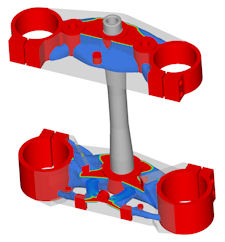 Fig. 4. Topology optimization results with manufacturing constraints applied. Image courtesy of Luxon MX.
Fig. 4. Topology optimization results with manufacturing constraints applied. Image courtesy of Luxon MX.“We do not want to artificially constrain the design with preconceived notions of how the design should take shape,” Wight says. “We start with optimization and see where the design wants to go.”
Optimization starts with a block of material, the “packaging space,” as Wight calls it. The optimization software then begins to remove material from this block to leave only the most efficient structure behind.
“Typically with structural components, the goals are high stiffness, high strength or low weight,” Wight says.
He adds that Luxon employed a type of optimization called topology optimization, which helps reveal the most efficient material placement within a given space. In the case of Luxon’s triple clamps, about 64% of the total volume was within the design space. That’s the amount of space available for use during the optimization routine. The remainder of that space is required for hard points — bolt locations, component attachments, etc. — and therefore cannot be used as a design variable.
The optimization routine runs the model through all of the loading conditions the components experience, and iterates to achieve the optimization goals. In Luxon’s case, 12 different non-linear loading conditions are simulated to accurately represent the real-life loading on the components. The company prepared finite element (FE) models of OEM components, as well as some aftermarket competitors’ parts (see Fig. 2). These models revealed the performance capabilities of the stock and competition products, giving Luxon a baseline on which to set its design goals.
“In our case, we want to meet the same stiffness as the stock components, but make them as light as possible while maintaining strength,” says Wight. “We must also create a product better than the competition.”
Exploring All Options
The optimization routines within the Altair software suite include various options to ensure the results are manufacturable for various processes.
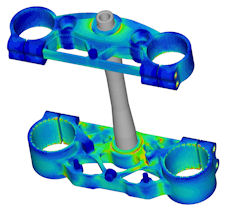 Fig. 5. FEA stress contours of an envelope encompassing all load cases reveal a consistent stress distribution. Image courtesy of Luxon MX.
Fig. 5. FEA stress contours of an envelope encompassing all load cases reveal a consistent stress distribution. Image courtesy of Luxon MX.“We always run the first optimization with minimal constraints, to see what the true optimum design looks like,” Wight explains. “Once we have the first results, we start adding the appropriate constraints to ensure manufacturability. This allows us to see the compromises we are making in order to choose a particular manufacturing process. There’s not one optimized design. There’s a different optimized design for each combination of goals and constraints.”
Because optimization is determined by the designer’s goals, Luxon uses multiple optimization approaches to view and analyze various design options — with consideration given to all the design variables and constraints used to meet the objectives the company sets out to achieve (see Figs. 3 and 4).
The topology optimization results drive the design.
“Using the topology results, we create an initial 3D CAD model for analysis and further optimization,” Wight says.
Luxon MX runs an FE analysis on the initial design to determine where it stands in relation to the OEM and competition components. The design is then further optimized using size and shape optimization routines within the Altair software. Finally, the design is evaluated using its FE model to compare its strength, stiffness and weight to that of the OEM and competing companies’ parts (see Fig. 5).
Tests, and More Tests
Once Luxon’s engineers are satisfied with the state of the design, they add the finishing touches to the CAD model and submit it for prototyping. The prototypes are then physically tested to validate all performance expectations.
“We prototype it from machined aluminum,” says Wight. “We always verify our designs in the real world. Our parts are running on two different bikes right now, as well as being subjected to physical testing on rigs to accurately measure performance metrics.”
The results? The final design of the triple clamps is 11.2 % lighter than stock with the same stiffness, and increased strength. The design is also stiffer, lighter and stronger than the competition’s products, according to Wight.
“It looks very different from anything else on the market,” says Wight. “The optimization leads to a very organic looking structure that is rather unique.”
Luxon MX’s first triple clamps are expected to be on the market the first quarter of 2015 (see Fig. 6). To learn even more about this case study, download a PDF presentation at www.luxonengineering.com/pdf/altair_atc_2013.pdf.
More Info
Subscribe to our FREE magazine, FREE email newsletters or both!
Latest News
About the Author
DE’s editors contribute news and new product announcements to Digital Engineering.
Press releases may be sent to them via [email protected].








